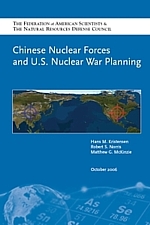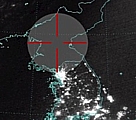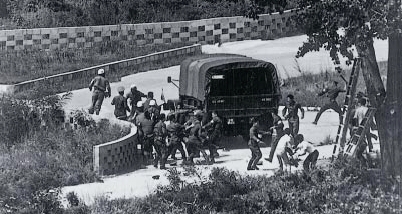Jason Releases Summary of Long-awaited Plutonium Aging Report
A key uncertainty affecting our confidence in the long-term reliability of nuclear weapons is the stability of the plutonium in the core, or “pit.” The pit is a sphere or shell of plutonium that is compressed by conventional explosives to create the supercritical mass required to sustain a nuclear chain reaction. In hydrogen bombs, this first part is called the primary. The energy of the primary is used to compress the fusion part of a hydrogen bomb or secondary. For large bombs, the great majority of the energy comes from the secondary, but if the primary produces too little energy, the secondary will fail completely.
(more…)
New Report: Chinese Nuclear Forces and U.S. Nuclear War Planning

An incipient nuclear arms race is emerging between China and the United States, according to a new report published today by the Federation of American Scientists and the Natural Resources Defense Council.
The 250-page report, Chinese Nuclear Forces and U.S. Nuclear War Planning, outlines the status and possible future development of China’s nuclear weapons, describes the history of U.S. nuclear targeting of China, and simulates nuclear strike scenarios between the two nuclear powers.
Both countries are pointing to the other as an excuse to modernize nuclear forces. In the United States the report finds that the Pentagon, the intelligence community, congressional committees, private institutes and the news media frequently overstate Chinese capabilities or present dramatic new developments out of context to underscore a threat.
China, for its part, cloaks its nuclear forces in a veil of secrecy, which creates suspicion and fear in other countries about Chinese intentions.
The report, which is based on analysis of declassified and unclassified U.S. government documents as well as commercial satellite images of Chinese installations, urges both countries to take steps to halt and reverse the tension and military build-up.
China’s Nuclear Forces
The report estimates that China has a stockpile of approximately 200 nuclear warheads, of which roughly 140 are deployed. About 100 of the warheads are for use by ballistic missiles while 40 are bombs for delivery by aircraft.
Given the almost complete lack of information from Chinese authorities about the size and composition of the stockpile, the FAS/NRDC estimate largely builds on analysis of declassified and unclassified assessments produced by U.S. government agencies over the years. Those assessments have been fraught with inaccuracy and inconsistency, the report finds, with a strong predisposition towards making worst-case predictions for stockpile size, weapons range and deployment.
This tendency continues today, and the report takes issue with the core prediction made by the intelligence community that says that the number of Chinese warheads primarily targeted against the continental United States will increase from 20 today to 75-100 warheads by 2015. The prediction assumes 40-55 new DF-31A missiles will be deployed over the next nine years in addition to the DF-31 and JL-2 missiles, a questionable estimate given that the DF-31A has not even been flight tested.
Chinese Submarines
The report discloses for the first time the number of patrols that Chinese submarines conduct each year. The capability of the Chinese submarines fleet is a hot issue following news media reports earlier this months about a Chinese submarine surfacing undetected near the USS Kitty Hawk carrier battlegroup off Okinawa, claims by the Pentagon that the Chinese navy is expanding its reach deep into the Pacific, and the U.S. Congress’ US-China Commission reporting earlier this month that China “continues to expand” its submarine fleet.
Yet the FAS-NRDC report shows that the Chinese submarine fleet is in steep decline from 120 submarines in the mid-1980s and expected by the U.S. navy to level out around 40 submarines in the next decade. The report shows that Chinese submarines rarely sail on patrol, that the entire submarine fleet in average conducts two patrols per year, that the most patrols conducted in a single year were six (in 2000), and that no patrols were conducted at all in 2005.
The report also reveals that China’s single ballistic missile submarine has never sailed on a nuclear deterrent patrol.
US Nuclear Targeting of China
Through analysis of declassified Pentagon documents, the report finds that U.S. nuclear targeting of China in the past has been considerably more prominent than normally assumed in the public debate. During the 1970s, for example, half of the major nuclear attack options in the U.S. strategic nuclear war plan were aimed at China.
After a hiatus in the 1980s precipitated by a joint U.S.-Chinese stand against the Soviet Union, U.S. nuclear targeting of China has increased after the end of the Cold War. The U.S. navy now bases the majority of its ballistic missile submarines in the Pacific, modernizing their nuclear missiles, and forward-deploying strategic bombers to Guam.
Nuclear Simulations
The report also presents the result of number of simulated nuclear strike scenarios between the two countries, showing that both have more than adequate capability to deter each other. The simulations are striking because they show that regardless of whether the strike is an imprecise Chinese “countervalue” attack on cities, or a highly accurate U.S. “counterforce” attack on military facilities, the result would be tens of millions of innocent civilian casualties.
A Chinese attack with 20 ICBMs would result in as many as 40 million casualties, the report estimates, and blanket large portions of the United States and Canada with radioactive fallout. Likewise, a limited and highly accurate U.S. nuclear attack on China’s 20 long-range ballistic missile silos would result in as many as 11 million casualties and scatter radioactive fallout across three Chinese provinces.
Take Google Earth Trip of Chinese Military Facilities
 |
|
Download the FAS-NRDC Google Earth file here. |
Making use of the unique capabilities of the free Google Earth program, FAS and NRDC have designed a virtual trip of selected nuclear and military facilities in China. Here is how to use it:
1. Download Google Earth onto your computer.
2. Click here or on the link below the map above to download the FAS-NRDC Google Earth file. The program will ask you to either open in Google Earth or download to your hard drive.
3. When Google Earth has finished loading on your computer, make sure the check-box “Chinese Nuclear Forces and U.S. Nuclear War Planning” in the “Places” window to the left is checked to activate the placemarks.
4. Click once on the first placemark (“Chinese Nuclear Forces and U.S. Nuclear War Planning”) to open the text “bubble” with information.
5. If all the placemarks have not opened automatically, click the “plus-box” to the left of the “check-box” in the “Places” window.
6. Those placemarks with an icon that looks like the Google Earth logo or a file-folder contain additional sub-placemarks. Click on the “plus-box” to open each folder. Note that some air bases contain sub-placemarks for each aircraft.
7. Double-click on each consecutive placemark to zoom in on each facility. Don’t forget to use the “tilt” and “rotate” functions of Google Earth to get a better view.
8. The last two folders contain graphic displays of nuclear strike simulations. These simulations are explained in detail in the Chapter 4 of the report (download from here).
Download: Full Report | Individual Chapters | Google Earth Map
US-China Commission Report Toned Down; Errors Remain

The annual report published Monday by the U.S.-China Economic and Security Review Commission is different – kind of toned-down – compared with the report published in 2005. The Commission hasn’t gone soft on China, and the report continues the strong critique of China that has characterized the Commission since it was established in 2000. But much of the stronger language from the 2005 report, and many of the more questionable claims about Chinese nuclear weapons capabilities, did not make it into the new report.
The toning-down of the report follows reports earlier this year that the Pentagon’s annual report on Chinese military capabilities was also softened before publication. A call to the US-China Commission office about why the changes were made was not answered.
Noticeable changes in the 2006 report compared with last year include:
* Deletion of the top recommendation that Congress should “encourage increasing U.S. military capabilities in the Western Pacific in response to growing Chinese capabilities.” This blunt call for an arms race is replaced in the new report with a recommendation that DOD includes in its annual report on China’s military power “an assessment of U.S. weapon systems, force structure, basing, doctrine, and tactics in order to maintain a favorable balance of military power in the region” to ensure that the Pentagon can beat the Chinese in a war.
* Deletion of the erroneous claim that China’s next-generation long-range nuclear ballistic missiles will carry multiple warheads. In last year’s report, this claim was based on two non-authoritative sources: a Heritage Foundation brochure and a Japanese news paper article. The U.S. intelligence community, in contrast, has consistently stated that the missiles will be equipped with single warheads.
* Deletion of the erroneous claim that the Chinese navy has nuclear-armed anti-ship cruise missiles.
* The section “Expansion of China’s Nuclear Forces” is now simply called “Missiles.”
While it is a positive development that the Commission has made these changes, the 2006 report by no means looses sight of the Commission’s mandate to report on China’s military modernization and force deployments. Yet there are several claims in the 2006 report that stand out:
* A big one is that China is said to be pursuing measures to “control” the seas in the “Western Pacific.” But as anyone with just a little knowledge of naval operations understands, gaining “control” over an area requires superior capabilities, something China simply does not have now nor is likely to acquire in the foreseeable future. It is one thing to try to achieve “control” of a limited coastal area between China and Taiwan, but quite another to achieve it in the “Western Pacific” as the Commission says.
* Another claim is that China “continues to improve its older intercontinental ballistic missiles,” which, although true, forgets to mention that this particular improvement of the DF-5 missile has been underway since the 1980s and is now finally nearing completion. Slow and long-term is typical for Chinese nuclear programs.
* The Commission also claims that a new missile currently under development – the DF-31A – “will be the first Chinese ICBM capable of hitting Washington, DC.” Not so, unless the U.S. intelligence community has been wrong or lying for 30 years. According to numerous declassified documents, unclassified official reports and official statements made by the intelligence community, China has been targeting all of the United States with the DF-5 since the early 1980s. But the suggestion that DF-31A has a longer range than DF-5 echoes information contained in the 2006 DOD report on China’s military forces. A map in that report showed a DF-5 range considerably shorter than shown on a map in the 2005 DOD report. Whether the U.S. intelligence community has decreased its estimate for the DF-5 range or simply made an error (that everyone keeps repeating) is unknown.
* The Commission report also claims that China “continues to expand” its submarine fleet, when, in fact, it is not. On the contrary, China’s submarine fleet is in sharp decline, down from approximately 120 boats in the mid-1980s to about 60 today. While the Commission report focuses on highlighting China’s acquisition of new submarines, U.S. Naval Intelligence anticipates that the Chinese submarine fleet will level out at around 40 boats.
Over the past two years, military-to-military contact has increased between China and the United states, not least thanks for the efforts of Admiral William J. Fallon, the commander of U.S. Pacific Command. Likewise, U.S. Strategic Command has begun direct conversions with its Chinese counterpart about the role of nuclear weapons. The U.S.-China Commission report acknowledges this development, but complains that the military-to-military contacts “may disproportionally benefit the” Chinese by increasing their knowledge of U.S. military capabilities.
To ensure that the United States doesn’t t fall behind, the Commission has a solution: increase U.S. spying against China. This is a curious recommendation, given that allegations about Chinese spying against the United States is what gave birth to the U.S.-China Commission in the first place.
The overall impression I get from the Commission’s report is that it spends too much time on reporting dramatic new developments and too little time on analyzing what its all means. To that end it is important not only to get the facts right but also to describe them in context. China is modernizing its military forces – as are virtually all of its neighbors including the United States. All these players are engaged in a dangerous game of deterrence that creates fear and suspicion and triggers requirements for better weapons and bolder war plans.
The challenge for the United States and its allies in the region is not, as the Commission seems to believe, to continue to deploy more and better weapons to counter China’s military modernization, but to figure out how to create a foreign policy that ends the mistrust.
|
New report |
Sally Lilienthal, Founder of Ploughshares Fund, Dies
Sally Lilienthal, the founder of the Ploughshares Fund, died on 24 October at age 87. All who knew her agreed that she was a force of nature. Some who have heard about the Ploughshares Fund do not realize how it actually works. It does not have an endowment. It is, itself, a fund-raising organization that passes on what it collects to individuals and groups working on issues of national security, particularly weapons of mass destruction. So Ploughshares has to go out and raise money each and every year. It is a huge task and one that depended on Ms. Lilienthal’s dedication. The Federation of American Scientists has been for years a major recipient of generous Ploughshares grants. These grants have been essential to supporting, for example, Hans Kristensen’s work on global nuclear forces and policies, my own work on the future direction of nuclear weapons, and Michael Stebbins’s work on the threat of bioweapons. There are very few foundations supporting studies and analyses in the field of peace and security and Ploughshares is the only organization that is devoted exclusively to the field. Without Ploughshares, you would hear a very different chorus of voices talking about international security. The Washington Post published an obituary.
Reaffirming the Nuclear Umbrella: Nuclear Policy on Autopilot
 In condemning the North Korean nuclear test and repeating its call for a denuclearized Korean Peninsula, one of the Bush administration’s first acts ironically has been to reaffirm the importance of nuclear weapons in the region.
In condemning the North Korean nuclear test and repeating its call for a denuclearized Korean Peninsula, one of the Bush administration’s first acts ironically has been to reaffirm the importance of nuclear weapons in the region.
“The United States will meet the full range of our deterrent and security commitments,” President Bush told Japan and South Korea after last week’s test. On Wednesday, Secretary of State Condoleezza Rice strongly hinted that the commitments potentially include nuclear strikes against North Korea.
But is it helpful or counterproductive at this stage to threaten North Korea with nuclear weapons?
(more…)
US Says North Korean Test Was Nuclear
In an extraordinarily brief statement, the Director of the National Intelligence Office announced that the United States has confirmed that North Korea’s large explosion last week was nuclear. How do they know and why did it take them so long to confirm?
(more…)
North Korea’s Bomb: A technical assessment [edited 16 October]
Last Sunday, North Korea apparently tested a nuclear explosive. The “apparently” is needed because the explosion was so small—by nuclear standards—that some have speculated that it may have been a large conventional explosion. What is the technical significance of the test, what does it mean, and what should we do now?
There is no question that the political and security implications of the test are huge and almost entirely negative. The technical implications are more mixed; the technical significance of the test is somewhat less than meets the eye.
(more…)
Article: Nuclear Threats Then And Now

A decision to trim a tree in the Korean demilitarized zone in 1976 escalated into a threat to use nuclear weapons. After a fatal skirmish between U.S. and North Korean border guards, U.S. forces in the region were placed on heightened alert (DEFCON 3) and nuclear forces were deployed to signal preparations for an attack on North Korea. The North Koreans did not interfere with the tree trimming again, so the threat must have worked, the Pentagon concluded.
Thirty years later, North Korea has probably developed nuclear weapons and is trying to develop long-range ballistic missiles to threaten you-know-who, and the United States has ventured into a multi-billion dollar effort to build a missile defense system and a “New Triad” to better dissuade, deter, and defeat North Korea and other “rogue” states.
So, did the threat work?
The “tree-trimming incident,” as the U.S.-North Korean scuffle has come to be known, and other examples of using nuclear threats are described in the article “Nuclear Threats Then And Now” in the Bulletin of the Atomic Scientists.
Plutonium Reprocessing: two steps forward, one step back.
The administration has submitted a $250M request to Congress to start work on a plutonium recycling program as part of its Global Nuclear Energy Partnership, or GNEP, proposal. Trying to figure out exactly what the proposal is has been like trying to nail Jell-o to the wall. Whatever criticism is raised, DOE responds that, no, it isn’t quite that. So I was getting a good picture of what GNEP was not but could not figure out what it was.
(more…)
Article: US National Security and Preemption
 The French magazine Défense Nationale asked me to submit an article about the new U.S. National Military Strategy published by the Bush administration in March 2006 and how it relates to the so-called preemption doctrine announced by the administration in 2002. The article is included in the July 2006 issue which focuses on the nuclear deterrence debate following the announcement by French president Jacques Chiraq in January that France has adjusted its nuclear posture to target regional adversaries armed with weapons of mass destruction. The magazine is published by the Committee for National Defence Studies, an independent research institution which includes several retired generals and admirals from the French military.
The French magazine Défense Nationale asked me to submit an article about the new U.S. National Military Strategy published by the Bush administration in March 2006 and how it relates to the so-called preemption doctrine announced by the administration in 2002. The article is included in the July 2006 issue which focuses on the nuclear deterrence debate following the announcement by French president Jacques Chiraq in January that France has adjusted its nuclear posture to target regional adversaries armed with weapons of mass destruction. The magazine is published by the Committee for National Defence Studies, an independent research institution which includes several retired generals and admirals from the French military.
Effort Underway in European Parliament Against US Nuclear Weapons in Europe
 A Written Declaration presented in the European Parliament calls for the withdrawal of US nuclear weapons from Europe by the end of 2006. The Declaration has until December 10 to gather support from at least half of the Parliament’s 732 members to be adopted and formally submitted to the US government. The initiative comes as Russia refused last week to discuss tactical nuclear weapons with the United States. Most European want the US to withdraw its remaining nuclear weapons from Europe.
A Written Declaration presented in the European Parliament calls for the withdrawal of US nuclear weapons from Europe by the end of 2006. The Declaration has until December 10 to gather support from at least half of the Parliament’s 732 members to be adopted and formally submitted to the US government. The initiative comes as Russia refused last week to discuss tactical nuclear weapons with the United States. Most European want the US to withdraw its remaining nuclear weapons from Europe.
Background report: U.S. Nuclear Weapons In Europe
US Air Force Publishes New Missile Threat Assessment
 The Air Force has published a new report about the threat from ballistic and cruise missiles. The new report, Ballistic and Cruise Missile Threat, presents the Air Force National Air and Space Intelligence Center’s (NASIC) assessment of current and emerging weapon systems deployed or under development by Russia, China, India, Pakistan, North Korea, Iran, Syria and others.
The Air Force has published a new report about the threat from ballistic and cruise missiles. The new report, Ballistic and Cruise Missile Threat, presents the Air Force National Air and Space Intelligence Center’s (NASIC) assessment of current and emerging weapon systems deployed or under development by Russia, China, India, Pakistan, North Korea, Iran, Syria and others.
Among the news in the report is a different and higher estimate for China’s future nuclear arsenal than was presented in the previous NASIC report from 2003. Whereas the previous assessment stated that China in 15 years will have 75-100 warheads on ICBMs capable of reaching the United States, the 2006 report states that this number will be “well over 100” warheads. NASIC also believes that a new Chinese cruise missile under development will have nuclear capability.
Also new is that NASIC reports that the Indian Agni I ballistic missile has not yet been deployed despite claims by the Indian government that the weapon was “inducted” into the Indian Army in 2004. Contrary to claims made by some media and experts, the NASIC report states that the Indian Bramos cruise missile does not have a nuclear capability. The Babur cruise missile under development by Pakistan, however, is assessed to have a nuclear capability.
A copy of the report, which was published in March 2006 and recently obtained by the Federation of American Scientists, is available in full along with previous versions here.